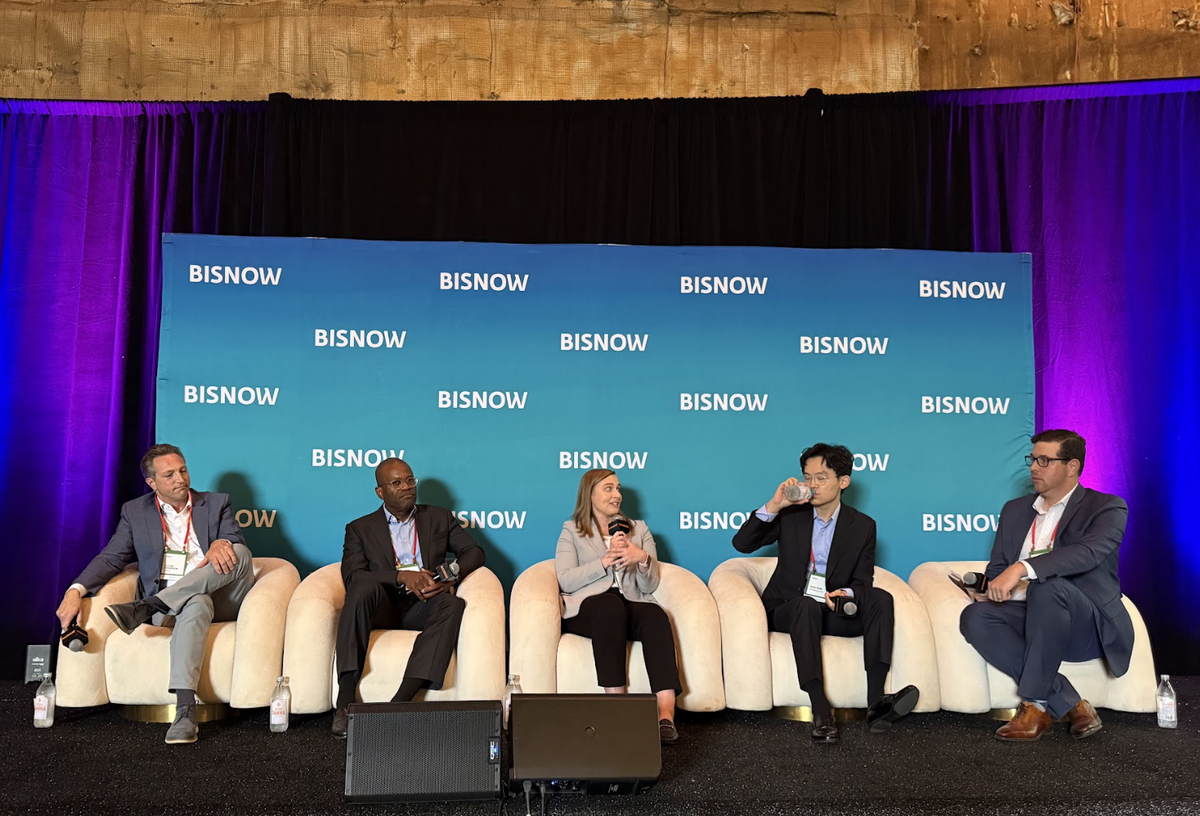
Bisnow/Samantha D’Angelo
UMTB USA’s Oliver Anderson, Arc Capital Partners’ Neville Rhone, Invesco’s Kate Bassett, The Cottonwood Group’s Tang Tang and CLA’s Carey Heyman.
The Los Angeles market is facing many of the same challenges as other markets across the country, but it has some additional hurdles for investors to clear, which has dissuaded some investors from placing capital in the city.
But while certain types of investors that once had a major presence in the area have receded, other types of buyers have stepped up to take their place, seeing opportunities where others might only see a minefield.
“You’re starting to see LA become a contrarian play,” Northmarq Managing Director Mike Smith said at Bisnow’s Los Angeles CRE State of the Market Conference.

Bisnow/Samantha D’Angelo
U.S. Green Building Council – California’s Ben Stapleton, Oaktree Capital Management’s Jason Keller, Genesis Builders’ Devang Shah, the city of Pasadena’s Rick Cole and CBRE’s Nicole Mihalka.
Smith said he has heard institutional capital leaders say that since Measure ULA and the pandemic eviction moratoriums, they are “redlining” Los Angeles, a term used to refer to the practice of historically denying federally backed mortgages and other financing to borrowers of color who were considered too risky to invest in at the time.
Those same institutional investors that see Los Angeles as too risky are nevertheless keeping an eye on the city and watching for a good point of entry, Smith told attendees at The Lot at Formosa.
While the cap rates still aren’t as low as some investors would like, there is anticipation among some that interest rates will drop soon and that might change the math, some panelists said.

Bisnow/Samantha D’Angelo
Avison Young’s James Nelson, Northmarq’s Mike Smith, CIM Group’s Victor Difede, Forge Development Partners’ Chris Fraley, KH Equities’ Daniel Mense and MGO CPAs’ Cesar Reynoso.
Smith said that across the country in the first half of the year, a little over half of the buyers for office properties were private, but in Los Angeles, that figure was about 70%.
“There’s a lot of private activity, there’s a lot of interest in contrarian investing, which is great to see, and there’s a lot to do here. This is a massive market,” Smith said.
Overall, panelists expressed confidence in at least pockets of the office market.
CIM Group Vice President of Investments Victor Difede said CIM is starting to look more at office again, adding that “really attractive quality office” is out there.

Bisnow/Samantha D’Angelo
Los Angeles Department of City Planning’s Kevin Keller, The Max Collaborative’s Kevin Ratner, California Landmark Group’s Ari Kahan and Weaver’s Evan Staggs.
But there was also great enthusiasm for conversions to residential, a badly needed product type in LA, where the multifamily vacancy rate hovers around 5%.
New York has incentivized the conversion of outdated office to residential with tax breaks, including up to a 35-year tax abatement. Those tax breaks make the sometimes complex projects financially feasible, Forge Development Partners Chief Investment Officer Chris Fraley said.
“Your taxes are 10% of what they would be otherwise for 35 years, and it works,” Fraley said. “That’s why we’re seeing so many conversions.”

Bisnow/Samantha D’Angelo
Wonderful Real Estate Development’s Joe Vargas, the city of Los Angeles’ Doane Liu, AEG Worldwide’s Kevin Rieger, Chargie’s Chris Vargas, the city of West Hollywood’s Laura Biery, Los Angeles Sports & Entertainment Commission’s Kathryn Schloessman and Shawmut Design & Construction’s Matt Stratton.
There are properties available for conversions. The office market in Los Angeles has largely struggled to find its way after the pandemic. A third-quarter report from CBRE found the office market has a roughly 24% vacancy rate.
While the office market sorts itself out, some in the industry saw a silver lining to the fact that others are hesitating to come back to Los Angeles.
“If there’s a flight of capital, then you know that that should, in theory, start to create more opportunities,” KH Equities President Daniel Mense said.
Multifamily was an area where panelists predicted rent growth, if only because they also anticipated a shortage in supply due in part to expected cautious sentiment among would-be developers about building new stock in the uncertain regulatory environment and in a market where Measure ULA is in place.

Bisnow/Samantha D’Angelo
Ledcor Development’s John Santry, Talo Management Group’s William Lowery, Greystar’s Raul Tamez, SOM’s Dan Herman and Greenberg Glusker’s Kevin Sher.
Mayor Karen Bass has sought to make changes to Measure ULA that seem aimed at mitigating some of the impacts that the commercial real estate industry highlights when talking about it, namely that it stifles new development and makes it harder to transact.
Bass teamed up with a pair of state legislators to propose, then hastily withdraw, state-level legislation that would have made those changes. Bass has promised to return with a new and improved version in January.
“Regulations that create heartaches for us, it’s the same reason why values just keep on going up, because you can’t build,” Mense said.

